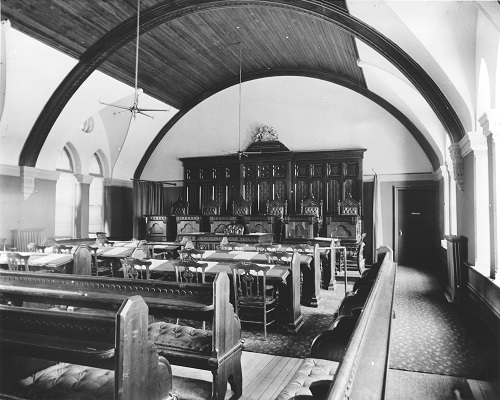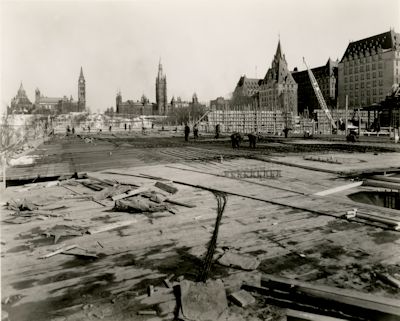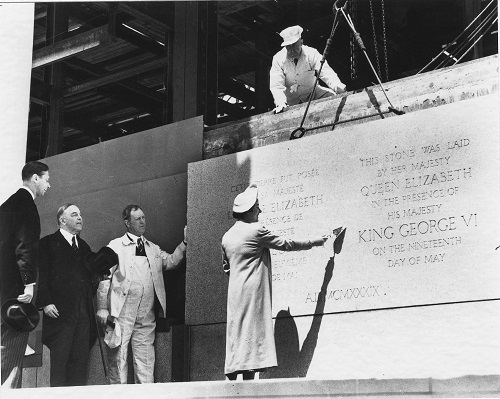History
The Supreme Court of Canada was established in 1875, 150 years ago.
The creation of the Court
The British North America Act, 1867, now called the Constitution Act, 1867, defined Canada’s current judicial system. Under it, the new federal Parliament was instructed to create a “General Court of Appeal for Canada”, leading to the creation of the Supreme Court of Canada. After the first 2 bills for its creation were withdrawn in 1869 and 1870, a new bill was passed on April 8, 1875. The politicians who played important roles in creating the Court were Sir John A. Macdonald, Télesphore Fournier, Alexander Mackenzie and Edward Blake.
Under the Constitution Act, 1867, the Governor in Council appoints all superior court judges in Canada, including judges of the Supreme Court of Canada. Once appointed, a judge can serve until the age of 75 and their salary is set and paid by Parliament. Judges are free to make decisions based on fact and law, without being influenced.
The first Chief Justice, the Honourable William Buell Richards, and the first Registrar, Robert Cassels were sworn in on October 8, 1875. The Court’s other judges signed their oaths of office in the Senate Chamber on November 8, 1875. The Court was inaugurated at a state dinner on November 18, and by mid-January 1876, the new Court had drafted a set of rules of procedure. At its first sitting on January 17, 1876, there were no cases to be heard. The first case heard was a reference from the Senate requesting the Court’s opinion on a private bill, in April 1876. The Court sat for 1 week in June 1876 to decide on 3 cases and started holding regular sessions in January 1877.
Decisions of the new Supreme Court could still be appealed to the Judicial Committee of the Privy Council in the United Kingdom, as were decisions of provincial courts. Oversight of the Court’s decisions by the Judicial Committee continued until 1933 for criminal appeals and 1949 for civil appeals.
The composition of the Court
The Court was originally composed of 6 judges. In addition to Chief Justice Richards, the original judges were William Johnstone Ritchie, Samuel Henry Strong, Jean-Thomas Taschereau, Télesphore Fournier and William Alexander Henry. At first, the judges of the Supreme Court were also judges of the Exchequer Court of Canada, a predecessor of the present-day Federal Court.

The number of Supreme Court judges was raised to 7 in 1927 and again in 1949 to reach the present total of 9 members. Of the 9 judges, the Supreme Court Act requires that 3 be appointed from Quebec. Traditionally, the Governor in Council appoints 3 judges from Ontario, 2 from the Western provinces or Northern Canada and 1 from the Atlantic provinces.
The Court’s building

The Court sat in the Parliament buildings until it moved to its own small 2-storey building at the foot of Parliament Hill on Bank Street, in 1882. Construction of the current Court building started in 1939. On May 20, 1939, Queen Elizabeth laid the cornerstone of the new building in the presence of her husband, King George VI. The Court took possession of its new building in January 1946 after delays caused by World War II and heard its first case there on February 5, 1946.


Watch a short video clip of the Queen’s visit:
It gives me great pleasure to be here today, to lay the foundation stone of a building devoted to the administration of justice in this great Dominion. Perhaps it is not inappropriate that this task should be performed by a woman; for a woman’s position in civilized society has depended upon the growth of law. Canada is rightly proud of being a land governed by the rule of law. Her judiciary and the members of her legal profession have been true to the highest British traditions of Bench and Bar.
[TRANSLATION]
In Canada, as in Great Britain, justice is administered in accordance with the two great but different legal traditions. In Scotland, where I was born, we have a justice system based on Roman law; it is founded on the same civil law as the venerable province of Quebec.
Today’s Supreme Court
The Court’s bench has changed significantly since 1875 and has evolved to reflect the diverse perspectives and experiences of Canadians.
Today, the Supreme Court of Canada is a pillar of our democracy, recognized around the world for its service to the Canadian population. The Court is highly regarded for its commitment to the fundamental principles of openness, transparency and judicial independence.
As we commemorate our 150th anniversary in 2025, we invite you to join us in reflecting on our history and legacy.
Related link
Educational poster – Consult the timeline of the history of the Supreme Court of Canada
